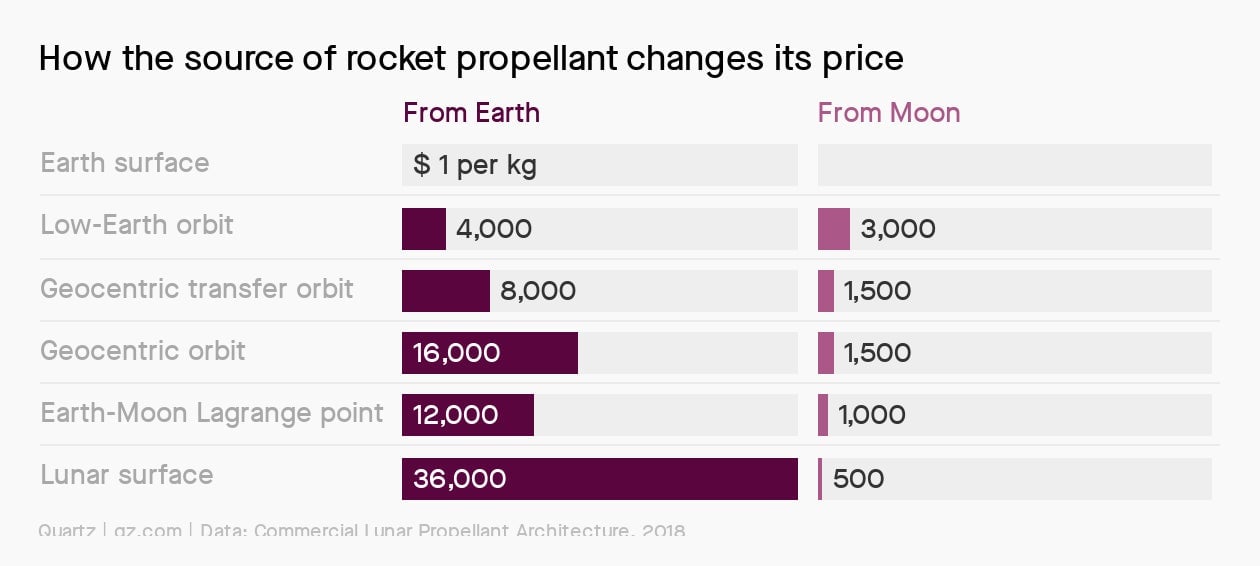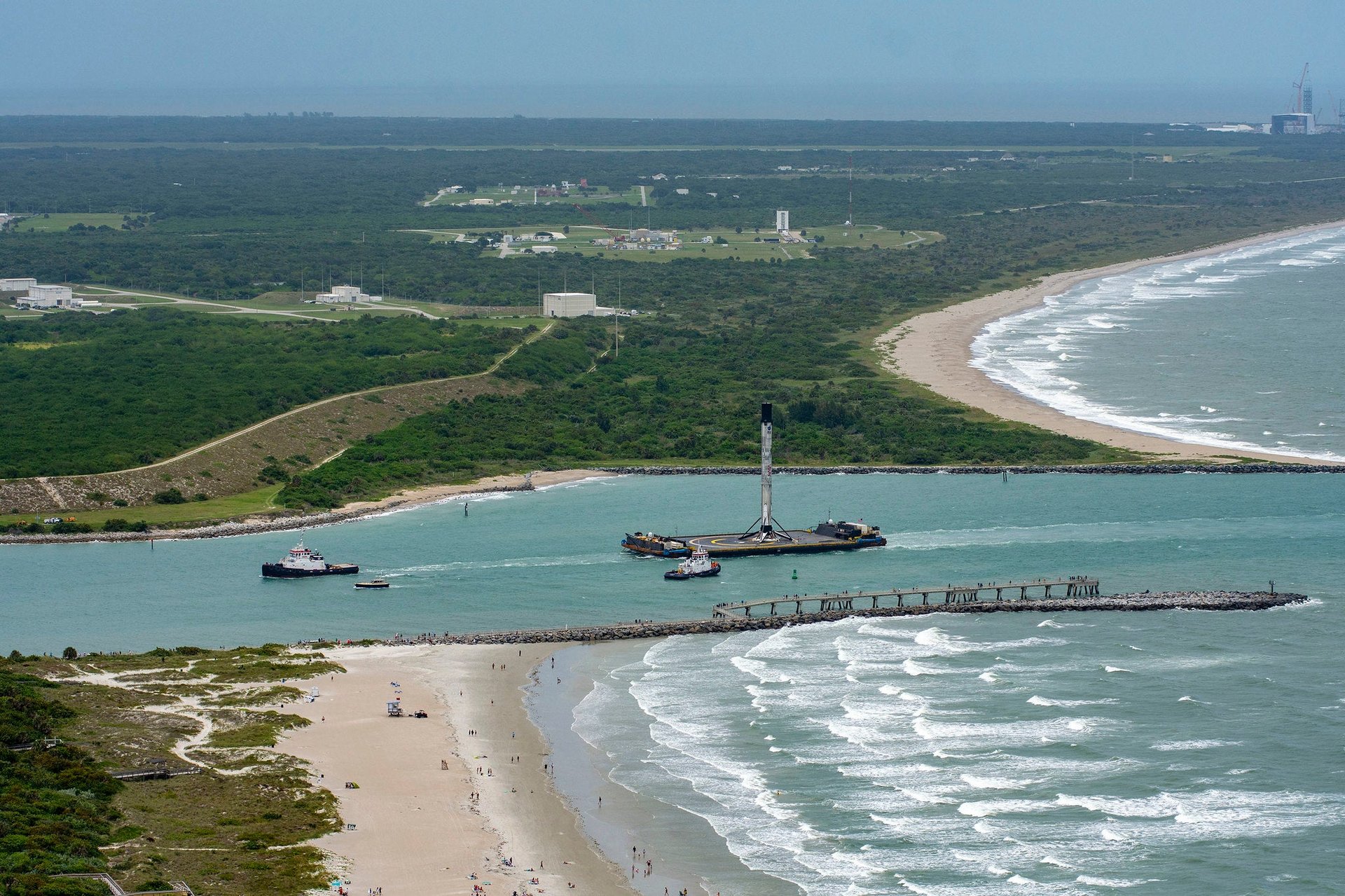Space Business: What price ice?
Dear readers,

Dear readers,
Welcome to Quartz’s newsletter on the economic possibilities of the extraterrestrial sphere. Please forward widely, and let me know what you think. This week: Ice innovation, Planet resolution, and Black people in aerospace.
🚀🚀🚀
The urge to voyage beyond what we know is at the heart of the human experience. Often, this is driven by some rare commodity—spices and silks, gold, or oil.
How about water?
The analogy may sound insane, since water is fairly plentiful here on the ground. But the unique physics of space travel means that going to the moon to get water might actually boost the space economy.
The presence of frozen water on the moon is a key motivating factor for plans to send a new wave of robotic and eventually human explorers back to the moon. That ice is one of the first real resources that humans can use in space—for drinking water, for hydroponic agriculture, and once split into its component elements, oxygen to breathe and propellant for rockets.
This week, NASA administrator Jim Bridenstine offered a hint as to how access to that water will come about, tweeting that “for the Artemis Moon base, NASA will establish a cost per ton delivered and once again let private companies innovate.”
Any talk of a moon base is a ways off: NASA’s current goal is to get astronauts back on the moon for a brief visit by the end of 2024, but that is unlikely to be realized. The viability of this dream also depends on how exactly the ice, which we’ve only spotted with remote sensors, is distributed on the moon. Robotic explorers expected to arrive in the next several years should help answer that question definitively.
But the water economy of space is too fascinating not to think about some more. The hinge of the whole idea is gravity. One of the most expensive things about space is getting there—escaping Earth’s gravity requires the use of chemical rockets to generate the massive energy needed to break free. That means paying a premium for anything you need to bring with you.
If those necessities were already available in space, the cost of getting the bare minimum up from Earth would go down significantly.
The chemicals behind rocket propellants are plentiful on Earth, but getting them to low-Earth orbit, where the International Space Station (ISS) lives, raises the price significantly. Going further, to geocentric orbits where satellites hang high above the Earth, is even more expensive. Take it to a Lagrange point between the Earth and the moon, a likely spot for a future space platform, or down to the moon, and the costs become astronomical.
Harvesting them on the moon, however, could be comparatively cheap, as is flying them from the moon’s low gravity to various orbits around the Earth. In theory, a market for lunar propellant could make it cheaper and more effective to operate large satellites by refueling them, instead of making them carry fifteen years’ worth of propellant up from the ground. That implies a host of benefits to life on Earth: Improved satellite internet and navigation services, better remote-sensing data about weather, climate change and economic activity, and the possibility for innovative new products manufactured in low-Earth orbit.
It could also lower the costs of operating the ISS, enable long-term stays on the moon, and make missions to Mars much cheaper, as well.
An analysis performed by the Space Resources Roundtable offers a suggestive depiction of how much it costs to produce and transport propellant—liquid oxygen and liquid hydrogen—to various points:

The challenge will be kick-starting the market—the capital investment required to create the infrastructure to extract water from lunar ice will be huge, and there’s no obvious buyer for it now.
That’s why Bridenstine’s statement is so important: If NASA follows through by saying we’ll pay $X for propellant delivered to location Y, that could give hypothetical lunar mining entrepreneurs the market they need to get off the ground, and encourage private propellant buyers to make their own plans to use these resources. (One technological wrinkle will be designing spacecraft for regular re-fueling.)
This is a model adapted from the commercial crew program we just saw carry astronauts to the space station on the cheapest spacecraft the US has ever built—tell the market what you need and let it provide, rather than develop a NASA-led effort. It’s proven an effective strategy for replicating past NASA accomplishments quickly and efficiently. But when it comes to mining the moon, well, that’s a new frontier.
🌘 🌘 🌘
Imagery Interlude
Speaking of transportation infrastructure, it can be easy to forget that getting to space is a multi-modal experience. It often takes a big airplane to move a big satellite to the right launch site. For SpaceX, reusing its Falcon 9 rocket means operating a small fleet, including its autonomous floating landing pads:

When it comes to moving big rocket boosters across the country, Aerojet Rocketdyne relies on trains:

That’s a serious warning on the back of that rail car, by the way.
👀 Read this 👀
Space-focused readers may not know your humble correspondent reports on other matters. This week, you may be interested in my story for this week’s field guide on China’s changing influence in the aftermath of the Covid-19 pandemic. In the last decade, national borrowers looked to China for loans that lack the strings attached to traditional credit. But today, as G20 nations debate debt forgiveness and deferral amid a worsening global recession, China is reluctant to ease its terms.
🛰🛰🛰
SPACE DEBRIS
Talk to your colleagues about race. Over the last week, I talked to a variety of Black people in aerospace to understand how they were experiencing protests against police violence and what they expect from a field that has not prioritized diversity. More than anything else, there is a desire for frank discussions about racism, long-overdue moves to bring more Black people into the space program, and critical thinking about how advanced technology affects inequality.
ENHANCE. Remote-sensing firm Planet hit another milestone this week by lowering the orbits of its SkySat fleet, allowing it to produce imagery at a resolution of 50cm per pixel. The company also plans to launch six more satellites over the summer to allow for frequent daily imaging at that level of quality.
Extended Stay America. It looks like the two astronauts who flew on the first crewed Dragon spacecraft will be spending the summer in orbit. Preliminary evidence suggests that their vehicle’s solar panels are holding up fine, so the two test pilots will get to remain on the ISS until August, performing research and a space walk or two. Now, the main factor for determining their return date will be the weather for the capsule’s ocean splashdown.
Subsidies for satellites? A debate is playing out over the eligibility of satellite firms to receive a share of $20 billion US subsidies for providing internet access in underserved rural areas. Satellite firms were initially excluded at the behest of terrestrial operators, but now the Federal Communications Commission has decided they can compete for a share of those funds. The decision could provide an extra financial boost for companies planning ambitious internet constellations like SpaceX, Amazon, Telesat or ViaSat—but critics say their technology isn’t yet proven enough for extensive government support.
Your pal,
Tim
This was issue 52 of our newsletter. Hope your week is out of this world! Please send your elaborate visions of the CIS-Lunar economy, experiences with racism in the aerospace industry, tips, and informed opinions to [email protected].